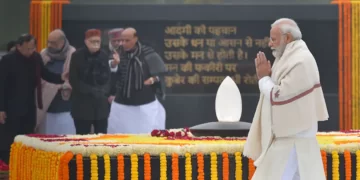The sacred Snana Purnima ceremonies are underway at the Puri Srimandir, signaling the start of the annual Rath Yatra celebrations. Thousands of devotees have arrived in the holy city to witness Lord Jagannath’s heavenly bathing ceremony alongside his siblings, Lord Balabhadra and Devi Subhadra.
The Snana Purnima is an important celebration in the Jagannath tradition, signaling the ceremonial start of the Puri Rath Yatra. The ceremony is thought to purify the deities and prepare them for their voyage in the chariot. According to mythology, King Indradyumna initiated the Snana Yatra when the deities’ idols were originally placed.
The Snana Purnima rites began early in the morning with a great Pahandi procession, which led the deities from the Ratna Sinhasana to the Snana Mandap, or bathing altar.
The bathing ceremony is a big display, with a set amount of pots of water donated to each deity.
35 pots of water are used to bathe Lord Jagannath, 33 pots for Balabhadra, 22 for Devi Subhadra, and 18 pots for Lord Sudarshan. The royal bathing ceremony uses 108 pots of water combined with scented herbs and sandalwood paste.
Following the ritualistic bath, the deities are thought to catch a disease and are then separated for 15 days, which is known as Anasara. During this time, the deities will be given herbal cures and a fruit-based diet to help them heal.
The quarantine period, or Anasara, begins with Jyestha Purnima and ends with Ashadha Amavasya.
with the evening, the servants would perform the ‘Hati Besha’ ceremony, which involves adorning the idols with elephant costume to represent Lord Ganesha. The Sahana Mela, or open darshan, will take place from 6:30 p.m. to 9:30 p.m., giving devotees a chance to see the magnificent appearance of the Holy Trinity.
The Snana Purnima is a festival of devotion, faith, and tradition that draws thousands of pilgrims to the Puri Srimandir. As the festivities continue, the city is buzzing with excitement, and the atmosphere is filled with spiritual fervour.







 Finance
Finance






